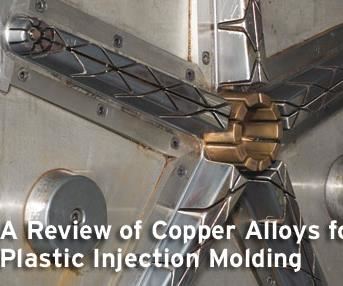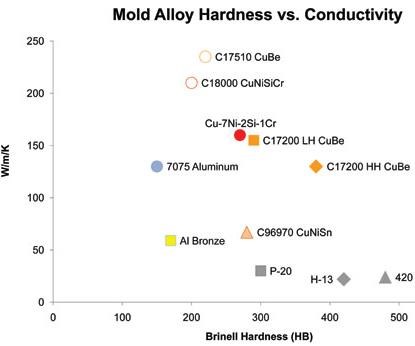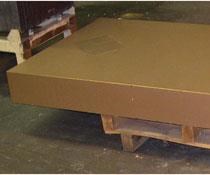A Review of Copper Alloys for Plastic Injection Molding
Copper alloys are attractive to the mold industry because of their high thermal conductivity, ease of machining by a variety of processes, and corrosion resistance to water, cooling fluids and the plastics being injected.
Copper is the most thermally conductive of the common solids; only silver, cubic boron nitride and diamond are more conductive. This makes copper an excellent choice for plastic injection molds that must remove heat from the injected, molten plastic to make it solidify. However, copper is neither hard nor strong enough in its pure form to serve as an injection mold. Fortunately, metallurgists have developed alloys of copper that retain much of the conductivity while attaining strength and hardness that approaches or even exceeds that of steels. The purpose of this article is to review those copper alloys now common to the injection molding industry.
Copper Alloy Classes, Attributes and Applications
There are four classes of copper alloys used in the injection molding industry. These are listed in Table 1. The least expensive of these is aluminum bronze (C62400 or C95400). Although less costly, it is also the softest and least conductive. The next class of alloy is the Corson bronzes. They include C18000 and the more heavily alloyed Cu- 7Ni-2Si-1Cr alloy. C18000 is available in large sections thickness and has moderate hardness and excellent conductivity. The Cu-7Ni-2Si-1Cr alloy while having good conductivity and hardness is not readily available in thicknesses greater than 6”. The next class of alloy is Cu-9Ni-6Sn spinodal copper (C96970). It has moderate conductivity and good hardness. It is available in large section thicknesses. The final class of alloys is the beryllium coppers, including C17510 with excellent conductivity and moderate hardness and C17200 with good conductivity and excellent hardness. These are the premier copper molding alloys, providing the highest hardness for a given conductivity. A chart of the hardness and conductivity of these alloys along with other common mold alloys is given in Figure 1.
The attributes of copper alloys that make them attractive to the mold industry are high thermal conductivity, ease of machining by a variety of processes, and corrosion resistance to water, cooling fluids and the plastics being injected. With thermal conductivity of two to 10 times that of common tool steels, these alloys can be used in injection mold core and cavity applications to remove hot spots, reduce warpage and reduce cycle time. This has been demonstrated in several studies.1,2 The overall effect is improved part quality and higher productivity.
To demonstrate the cooling efficiency of high conductivity mold materials, a study was conducted in which polycarbonate ophthalmic lenses were molded in 24 W/m/K (14 Btu/hr/ft/˚F) 420 stainless steel inserts and also in 130 W/m/K (75 Btu/hr/ft/˚F) C17200 copper alloy inserts. The polycarbonate lenses were 2 mm thick and formed from an ophthalmic grade polycarbonate injected at 310˚C. Cooling water was circulated at 55˚C. Thermographic images of the lenses ejected from the mold are shown in Figure 2. The images show that even with a cooling cycle 60 percent shorter (10 vs. 25 seconds) the high conductivity copper mold removed more heat than the stainless steel mold.
Copper alloys are traditionally used in core applications where the copper attains a lower temperature than would steel in a difficult-to-cool area, enabling the plastic in these areas to solidify more quickly. With proper design, inserts can be added to trouble spots in a steel mold after initial fabrication and first article operation of the mold so that hot spots can be reduced and dimensional stability from shot to shot can be improved. An example of an inserted core used to solve a molding problem is shown in Figure 3.
A number of fabrication methods can be employed to produce an injection mold from copper alloys. Alloy producers cast or forge copper alloys into a variety of shapes (e. g. rod, rings and disks), minimizing the amount of input material needed compared to taking material from plate. When needed, most of the copper alloys, can be made into large plates, to aid in the molding of large parts. An example of this is shown in Figure 4, a 2½ ton C17200 copper beryllium block.3 The high conductivity and low modulus of copper alloys allow the use of high speed machining, allowing the fabricator to achieve metal removal two to five times higher than possible with steel in milling turning and drilling processes. Copper alloys can also be welded. Specialized heat treatments can improve the loss of hardness these alloys experience from the high temperatures of the welding process. Finally, a variety of coatings can be applied to copper alloys to increase durability and facilitate mold release.
Summary
With cycle time reduction and mold durability being two of the keys to profitable injection molding, the high thermal conductivity and good strength of copper alloys make them an important tool of the injection molder. Mold builders now have many copper alloys and fabrication methods at their disposal to realize efficient and durable molds.
References
1Paul Englemann, Eric Dawkins, Jay Shoemaker and Michael Monfroe, “Applying Copper Alloys Using New Mold Cooling Software,” SPE ANTEC Proceedings, (1996).
2Paul Englemann, and Eric Dawkins, “Copper vs. Steel Cores: Process Performance, Temperature Profiles and Warpage,” SPE ANTEC Proceedings, (1997).
3 J.C.Kuli, R.E. Kusner, “Advances in Copper Alloy Mold Materials for Plastic Injection & Blow Molding” MS&T Proceedings (2007)
Related Content
How to Machine Aluminum Molds to Enhance Efficiency and Quality
Ways to optimize the machining process to fully leverage the benefits of an aluminum mold.
Read MoreHow is an Aluminum Mold Energy-Efficient?
Nine ways aluminum molds save energy and production costs.
Read MoreCast Plate Aluminum Alloy is Suitable for Production Mold and Dies
Alimex Precision in Aluminum introduces its 7000 series ACP7 mold material, featuring high mechanical properties, material stability and good machinability.
Read MoreHow to Select the Right Tool Steel for Mold Cavities
With cavity steel or alloy selection, there are many variables that can dictate the best option for moldmaking.
Read MoreRead Next
Rebuilding Tools with High Performance Material
High-performance alloy offers a unique combination of thermal conductivity and strength—providing numerous benefits to the moldmaker and molding process.
Read MoreAre You a Moldmaker Considering 3D Printing? Consider the 3D Printing Workshop at NPE2024
Presentations will cover 3D printing for mold tooling, material innovation, product development, bridge production and full-scale, high-volume additive manufacturing.
Read MoreReasons to Use Fiber Lasers for Mold Cleaning
Fiber lasers offer a simplicity, speed, control and portability, minimizing mold cleaning risks.
Read More












.jpg;maxWidth=300;quality=90)













.jpg;maxWidth=970;quality=90)